
The hooked squid, family Onychoteuthidae, currently comprise about 20–25 species, in six or seven genera. They range in mature mantle length from 7 cm to a suggested length of 2 m for the largest member, Onykia robusta. The family is characterised by the presence of hooks only on the tentacular clubs, a simple, straight, funnel–mantle locking apparatus, and a 'step' inside the jaw angle of the lower beak. With the exception of the Arctic Ocean, the family is found worldwide.

Pyroteuthidae is a family of squids. The family comprises two genera. Species are diurnally mesopelagic, migrating into surface waters during the night. The family is characterised by the tentacles, which have a permanent constriction and bend near the base; and photophores occurring on the tentacles, eyeballs, and viscera. Members reach mantle lengths of 23–50 mm. Paralarvae of the family are common around the Hawaiian Islands, with up to 17% of collected specimens in the area belonging to Pyroteuthidae.

Thysanoteuthis is a genus of large squid comprising one well-known species, the diamond squid, and two dubious taxa.
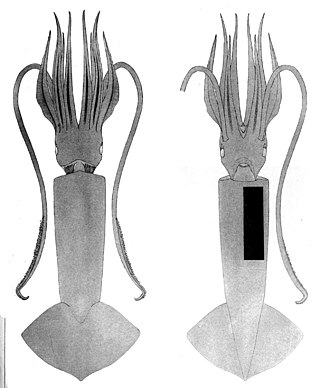
Pholidoteuthis is a genus of squid in the monotypic family Pholidoteuthidae, comprising at least two species. The defunct genus Tetronychoteuthis was previously incorporated into Pholidoteuthidae based upon a singular taxon known as Tetronychoteuthis massyae. Following the discovery of Pholidoteuthis boschmai in 1950, T. massaye was placed into Pholidoteuthis, with Tetronoychoteuthis considered a nomen dubium. P. boschmai is now considered a junior synonym of P. massyae.
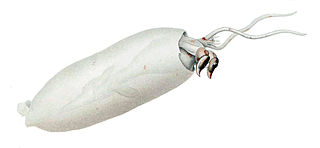
Taoniinae is a subfamily containing ten genera of glass squids.

Onykia ingens, the greater hooked squid, is a species of squid in the family Onychoteuthidae. It occurs worldwide in subantarctic oceans.

Onykia robusta, also known as the robust clubhook squid and often cited by the older name Moroteuthis robusta, is a species of squid in the family Onychoteuthidae. Reaching a mantle length of 2 m (6.6 ft), it is the largest member of its family and one of the largest of all cephalopods. The tentacular clubs are slender, containing 15–18 club hooks. Arms of the species contain 50–60 suckers, and grow to 90–100% of the mantle length. It is found primarily in the boreal to Temperate Northern Pacific.

Onykia carriboea, the tropical clubhook squid, is a squid in the family Onychoteuthidae, the type species of the genus Onykia. It is known with certainty only from immature specimens. The type locality of O. carriboea is the Gulf of Mexico. Onykia robsoni has been suggested as a junior synonym, owing to similarities between the species.
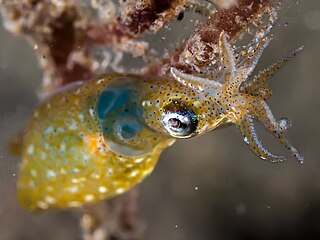
Idiosepiidae, also known as the pygmy squids, is a family of squids in the superorder Decapodiformes. They are the smallest known squids.

Xipholeptos is a genus of squid in the family Idiosepiidae. It is monotypic, being represented by the single species Xipholeptos notoides, commonly known as the southern pygmy squid. The species was originally classified as Idiosepius notoides. The southern pygmy squid is native to the southwestern Pacific Ocean, off southern and eastern Australia. It inhabits shallow, inshore waters. It has been recorded off the coasts of New South Wales, South Australia, Tasmania and Victoria.
Moroteuthopsis is a genus of squid in the family Onychoteuthidae. The type species is Moroteuthopsis longimana.
Filippovia knipovitchi, the smooth hooked squid, is a species of squid in the family Onychoteuthidae and the sole member of the genus Filippovia. It is found in the Antarctic and Atlantic Oceans, and reaches a mantle length of 35 cm.
Onykia loennbergii, the Japanese hooked squid, is a species of squid in the family Onychoteuthidae, named for Swedish zoologist Einar Lönnberg. It occurs in the Western Pacific Ocean, at an estimated depth of 230–1200 m. The mantle length is approximately 300 mm. Each tentacular club contains 25 hooks. The arms are about 60% of the size of the mantle length.

Onykia robsoni, the rugose hooked squid, is a species of squid in the family Onychoteuthidae. It occurs in the Antarctic Ocean, at an estimated depth of 250–550 meters. The mantle of this species grows to a length of 75 cm. The species has been suggested as a junior synonym of Onykia carriboea, the tropical clubhook squid, due to similarities between the species.

Onychoteuthis borealijaponica, the boreal clubhook squid, is a species of squid in the family Onychoteuthidae. It is the largest member of the genus Onychoteuthis, reaching a mantle length of 30 cm in males and 37 cm in females. Maturity is reached at 250 mm for males, and 300–350 mm in females. There are 24–27 hooks on each club, which is more than any other species in the genus Onychoteuthis. It is a pelagic species native to the North Pacific, although it migrates into Subarctic waters during the summer from its more southerly winter spawning grounds.
Notonykia is a genus of squid in the family Onychoteuthidae. The type species is Notonykia africanae.
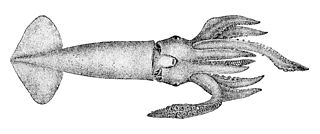
Nototodarus is a genus of squid. Example species in this genus include Nototodarus sloanii, a species sought for human food; in the process of harvesting N. sloanii Australian sea lions are frequently killed, since that marine mammal preys upon this squid species. Furthermore, New Zealand arrow squid, N. sloanii, is an important food source for the endangered yellow-eyed penguin, Megadyptes antipodes.

Todarodinae is a squid subfamily in the family Ommastrephidae.
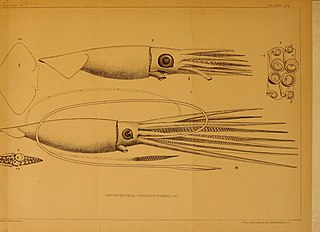
Sthenoteuthis is a genus of small squids, with two species, part of the subfamily Ommastrephinae within the family Ommastrephidae, the "flying squids". They are the dominant species of flying squid in the world's tropical and subtropical seas and they are commonly seen at the ocean's surface during the night. Their size ranges from mantle lengths of 100 mm to 600 mm.
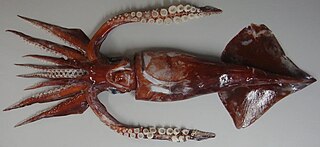
Todarodes is a genus of flying squid from the subfamily Todarodinae, of which it is the type genus. The genus contains five species which are partially allopatric but between them their distributions encompass most of the world's oceans and seas. These squid have a funnel groove with foveola, a hectocotylised fourth arm and tentacular stalks which lack free trabeculae.
















